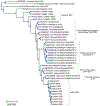Apollo Rising: Acute Conjunctivitis Outbreak in India, 2022
- PMID: 37719281
- PMCID: PMC10501505
- DOI: 10.1097/coa.0000000000000009
Apollo Rising: Acute Conjunctivitis Outbreak in India, 2022
Abstract
Purpose: To identify pathogens associated with the 2022 conjunctivitis outbreak in Tamil Nadu, India.
Methods: This prospective study was conducted in November of 2022. Patients with presumed acute infectious conjunctivitis presenting to the Aravind Eye Clinic in Madurai, India were eligible. Anterior nares and conjunctival samples from participants were obtained and processed for metagenomic RNA deep sequencing (RNA-seq).
Results: Samples from 29 patients were sequenced. A pathogen was identified in 28/29 (97%) patients. Coxsackievirus A24v, a highly infectious RNA virus, was the predominant pathogen and detected in 23/29 patients. Human adenovirus D (HAdV-D), a DNA virus commonly associated with conjunctivitis outbreaks, was detected in the remaining patients (5/29). Hemorrhagic conjunctiva was documented in both HAdV-D and coxsackievirus A24v affected patients but was not the predominant clinical presentation. Phylogenetic analysis of coxsackievirus A24v revealed a recent divergence from the 2015 outbreak.
Conclusions: Coxsackievirus A24v and HAdV-D were co-circulating during the 2022 conjunctivitis outbreak in Tamil Nadu, India. Clinical findings were similar between patients with HAD-V and coxsackievirus A24v associated conjunctivitis. As high-throughput technologies become more readily accessible and cost-effective, unbiased pathogen surveillance may prove useful for outbreak surveillance and control.
Figures



References
-
- Humans Sommer A., Viruses, and the Eye-An Early Report From the COVID-19 Front Line. JAMA ophthalmology 2020;138:578–9. - PubMed
-
- Thompson PP, Kowalski RP. A 13-year retrospective review of polymerase chain reaction testing for infectious agents from ocular samples. Ophthalmology 2011;118:1449–53. - PubMed
Grants and funding
LinkOut - more resources
Full Text Sources
Research Materials
